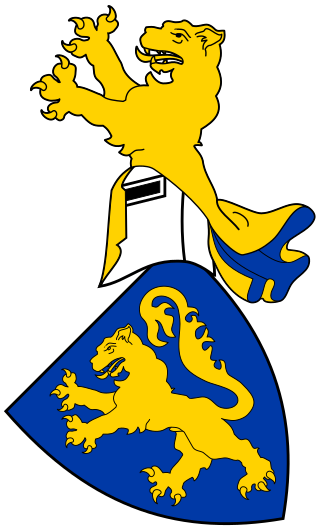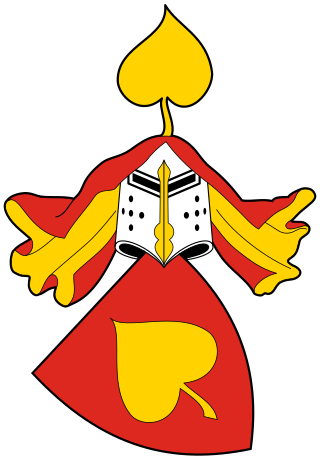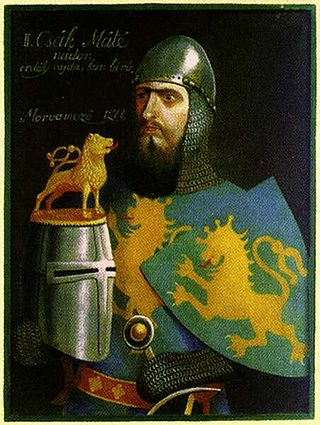Related Research Articles

Ugrin (III) from the kindred Csák was a prominent Hungarian baron and oligarch in the early 14th century. He was born into an ancient Hungarian clan. He actively participated in the various internal conflicts during the era of feudal anarchy since the reign of Ladislaus IV of Hungary. He held various dignities in the royal court in the 1270s. Simultaneously, he established a province surrounding his centre Syrmia in the southern parts of the kingdom.

Csák was the name of a gens in the Kingdom of Hungary.

Győr was the name of a gens in the Kingdom of Hungary. The ancestor of the kindred was a German knight, who arrived to Hungary in the first half of the 11th century. His descendants settled down in Transdanubia. The last scion of the family died in the 17th century.

Rátót was the name of a gens in the Kingdom of Hungary. According to Simon of Kéza and other chroniclers, the ancestors of the clan were Italians from Caserta, Naples, by name Rathold and Oliver, who settled down in Hungary around 1097 during the reign of Coloman, King of Hungary. They came to Hungary alongside Felicia of Sicily.

Matthew (II) from the kindred Csák was a powerful Hungarian baron, landowner and military leader, who held several secular positions during the reign of kings Béla IV, Stephen V and Ladislaus IV. He was the first notable member of the Trencsén branch of the gens ("clan") Csák. His nephew and heir was the oligarch Matthew III Csák, who, based on his uncles' acquisitions, became the de facto ruler of his domain independently of the king and usurped royal prerogatives on his territories.

Nicholas from the kindred Pok was a Hungarian influential lord in the Kingdom of Hungary at the turn of the 13th and 14th centuries. He held positions in the royal court in the 1270s. He acquired extensive landholdings and estates in the area between the rivers Tisza and Szamos (Someș). He was among the so-called oligarchs, who ruled de facto independently their dominion during the era of feudal anarchy. He was also ancestor of the Meggyesi noble family, thus later charters also referred to him as Nicholas Meggyesi.
Finta from the kindred Aba was a Hungarian lord in the Kingdom of Hungary, who served as Palatine of Hungary from 1280 to 1281. He is best known for capturing King Ladislaus IV of Hungary in early 1280.
Atyusz was the name of a gens in the Kingdom of Hungary, several prominent secular dignitaries came from this kindred.

Hahót or Hahót–Buzád was the name of a gens in the Kingdom of Hungary, several prominent secular dignitaries came from this kindred. The last noble family, which originated from the kindred, became extinct in 1849.
Atyusz from the kindred Hahót was a Hungarian noble, who served as ispán of several counties in the second half of the 13th century. He was also the ancestor of the Szabari noble family.
Péc or Pécz was the name of a gens in the Kingdom of Hungary. The powerful and illustrious Marcali and Apponyi noble families descended from this kindred. The clan had large-scale possessions in several counties of Transdanubia, in addition to Slavonia and other parts of the Kingdom of Hungary.
Budmér was the name of a minor gens in the Kingdom of Hungary, which possessed lands in Southern Transdanubia, mostly Baranya County.
Dominic from the kindred Csák was a Hungarian lord in the 13th century. Initially, he was a confidant of rex iunior Stephen, but later joined the partisans of the elderly Béla IV of Hungary. During the era of feudal anarchy, he served as a courtier of Queen Dowager Elizabeth the Cuman.
Emeric from the kindred Csák was a Hungarian lord in the 13th century, who served as ispán of Somogy County from 1272 to 1273.
Tétény was the name of a gens in the Kingdom of Hungary. Initially having roots in Central Hungary, they mostly possessed lands beyond the river Drava in the territory of Slavonia. The kinship reached its peak in the first third of the 13th century. The noble Pekri family descended from this clan.
Peter (II) from the kindred Tétény was a Hungarian baron in the second half of the 13th century, who served as Ban of Slavonia three times. He was a faithful confidant of King Ladislaus IV of Hungary in his fight against the oligarchic domains. Peter was forefather of the Pekri noble family.

The Tibai or Tibay family was a noble family in the Kingdom of Hungary, which possessed lands mostly in Ung and Szatmár counties. The family originated from the Nagymihály branch of the ancient Hungarian gens (clan) Kaplon. The illustrious Sztáray family is a cadet branch of the Tibais.
Szolnok (Zounuk) was the name of a gens in the Kingdom of Hungary. The founder of the clan was the 11th-century royal official Szolnok, about whom Szolnok County, becoming its first ispán, was named. Beside that region, his descendants acquired lands Nógrád, Fejér and Baranya counties too.

Lőrinte or Lőrente was the name of a gens in the Kingdom of Hungary, which possessed lands in Transdanubia, mainly Veszprém and Zala counties. The Essegvári and Bezerédj families descended from this clan.
Negol (Nygol) was the name of a minor gens in the Kingdom of Hungary, which possessed lands in the southern parts of Transdanubia, mainly Baranya County.
References
- ↑ Karácsonyi 1900, p. 854.
- ↑ Zsoldos 2011, p. 219.
- 1 2 3 4 5 Karácsonyi 1900, p. 855.
- ↑ Szentpétery 1930, pp. 466–468.
- ↑ Engel 1996, p. 102.
- 1 2 Karácsonyi 1900, p. 856.
- ↑ Engel 1996, pp. 104, 222.
- ↑ Engel: Genealógia (Genus Németi, Kisasszonyfalvi branch)
